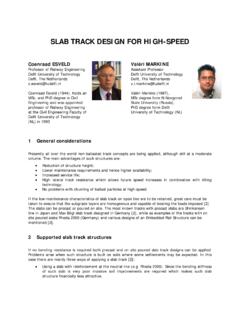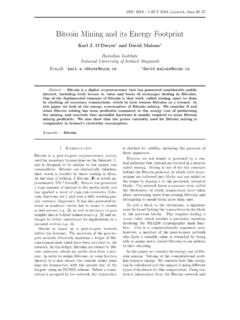Transcription of SLAB TRACK Recent developments in slab track - …
1 With the growth of traffic intensity itbecomes more and more difficult to carryout maintenance and renewal work. InThe Netherlands, night time possessions often lastno longer than 5 hours, and on the future high speedline in Korea (435 km from Seoul to Pusan) the max-imum effective possession is estimated at no morethan 11/2hours per night. In this respect, the currentincrease in popularity of low-maintenance trackdesigns is not the past, new projects were mainly assessed onthe basis of investment costs, whereas today the prin-ciple of life cycle costing is strongly emerging. As aresult of this new attitude, ballastedtrack concepts will loose attractive-ness in favour of slab TRACK considerationsPresently all over the world non-bal-lasted TRACK concepts are beingapplied, although still at a moderatevolume. The great advantages of suchstructures can be summarised as fol-lows: Reduction of structure height; Lower maintenance requirementsand hence higher availability; Increased service life; High lateral TRACK resistancewhich allows future speedincreases in combination with tilt-ing technology; No problems with churning ofballast particles at the low-maintenance characteristics of slab trackon open line are to be retained, great care must betaken to ensure that the subgrade layers are homoge-nous and capable of bearing the loads imposed.
2 Theslabs may be prefabricated or poured on site. Thehigh level of investment required has preventedwidespread use of slab TRACK on open line so , on the basis of life cycle costs a differentpicture is obtained [1]. The greatest savings will beachieved in tunnels and on bridges. The use of moreefficient construction methods, of the type used inthe road construction industry, could reduce con-struction costs further principlesGenerally speaking there are two ways of designingslab TRACK . According to the German school, basedon highway design, the supporting layer should havea substantial bearing stiffness, represented by themodulus of elasticity Ev2 *120 N/mm2. Thisrequirement refers in particular to slabs on a sub-grade and is originated by the fact that incoherentblock structures, having no bending resistance, couldbe used. This requirement also covers the conditionthat no differential settlements may occur.
3 Slabsdesigned in this way only contain reinforcement ineuropeanrailway review81 slab TRACKR ecent developments inslab TRACK Coenraad Esveld,Professor of Railway Engineering, Delft University of Technology DelftWith the design of railway lines factors like life cyclecost, construction time, availability and durability playan increasingly important role. In this respect, non-ballasted TRACK concepts offer good opportunities. Fig. 1: Shinkansen slab 23/5/03 10:08 am Page 1europeanrailway review82the neutral axis to control crack width in the con-crete. This is standard practice in Germany. On engi-neering structures like bridges and tunnels, providingrigid supporting conditions, this is a logical , when slabs are built on subgrades oftenmassive soil improvements are required, which makeslab tracks financially second way of constructing slabs, especiallyon soils where some settlements may be expected, iswith reinforcement at the top and at the bottom ofthe slab to take bending stresses and axial studies at TU Delft have shown that rela-tively high reinforcement percentages of about %for a B35 concrete [2, 3, 4, 5, 6].
4 On the other handonly very limited soil improvements are no bending resistance is required, prefabri-cated slab sections can be used. On bridges this hasthe advantage that the influence of bending of thebridge has no influence on the bending stresses in thetrack (semi) continuous slabs are applied the con-struction method can consist of either pouring theconcrete into a casing, or constructing continuouslyusing a slipform paver. The price is, to a large extent,determined by the building for slab tracks it is important to con-trol the TRACK geometry carefully during construc-tion, as corrections afterwards are difficult. Perhapseven more important is to make the welds at verytight tolerances to avoid impact loads which have astrong negative influence on the service life of theentire systems in useJapan was effectively the birthplace of high speedrail. development work on the Shinkansen networkstarted at the end of the 1950s, and the first line(between Tokyo and Osaka) opened in autumn lines are currently in service and a sixth is underconstruction.
5 Government plans dating back to 1970specify a national Japanese high speed network of 3500 km of double TRACK . By 1993, a good 1 400 kmof this had been built (double TRACK ), of which morethan 1 000 km consists of ballastless double TRACK . InJapan, ballastless TRACK always consists of prefabri-cated slabs just under 5 m long. The percentage ofballastless TRACK varies considerably from line to newer lines include a higher percentage (up to96 %). The slab TRACK design has remained virtuallyunchanged since the first sections were laid in Shinkansen slab TRACK (Figure 1, pg. 81) con-sists of a sublayer stabilised using cement, cylindrical stoppers to prevent lateral and longitudinal move-ment, reinforced pre-stressed concrete slabs measur-ing m x m x m ( m x m x in tunnels) and asphalt cement mortar injectedunder and between the slabs. The slabs weighapproximately 5 TRACK was undergoing rapid develop-ment in Germany.
6 Since 1996, DB has been operat-ing a test TRACK in Karlsruhe consisting of seven newtypes of ballastless TRACK . The best-known Germandesign is the Rheda system. There are numerousvariants which indicate that the initial designs werenot completely successful. The most developedRheda system is Rheda 2000 [7]. By eliminating theconventional concrete trough, a significant simplifi-cation of the overall system con-figuration wasachieved. As a result, the entire cross section of theslab has become one monolithic component. Due tothe elimination of the trough and the use of twin-block sleepers, a considerable reduction of the struc-Fig. 2: Rheda 2000 Fig Block SystemFig. 3: B gl slab TRACK 23/5/03 10:08 am Page 2tural height could be achieved as is revealed by thedimensions in Figure 2, pg. Germany a prefabricated slab TRACK system,produced by B gl, is in use. This system is largelysimilar to Shinkansen slabs except that the B gl slabsare made of B55 steel fibre reinforced concrete andare 20 cm thick, m long, and or mwide.
7 The slabs are pre-stressed in lateral direction;in longitudinal direction traditional reinforcement isapplied. Spindles integrated in the slabs provide aneasy and quick adjustment of the slabs (Figure 3,pg. 82). The slabs are connected longitudinally bypost-tensioned steel rods in the neutral infrastructure of the High-Speed Line Southin The Netherlands is built according to a so-calledDBFM contract (Design, Build, Finance, Maintain)and was awarded to Infraspeed, a consortium com-prised of Fluor Daniel, Siemens and KoninklijkeBAM Groep. In this contract the availability of theinfrastructure is guaranteed at a specified level for 25years. The TRACK consists of a low viaduct consistingof a piled concrete slab , with on top a separate slabwith Rheda 2000 TRACK . Both supporting structureand Rheda slab are dilated at intervals of 35 m tolimit the longitudinal forces in the concrete andthe displacements at the end of the structure.
8 Thevertical relative displacements between the substruc-ture elements at the expansion should be confinedto French Stedef system is most often used intunnels, especially for metro systems. However, thetechnique is also used on high speed networks. Arubber boot under the sleeper provides a high degreeof elasticity, which ensures good noise and vibrationinsulation. The Sonneville Low Vibration TRACK isclosely related to the Stedef system. This is a blockFig. 5: Embedded rail TRACK near Best (NL)Fig. 6: Low niose SA 23/5/03 10:08 am Page 3europeanrailway review84track design, which, like Stedef, also uses a rubberboot. Applications include the Channel twinblock variant related to Stedef is theSwiss Walo system, mainly used in tunnels. A specialslipform paver lays a concrete slab , following whichthe sleepers fitted with rubber boots are placed inposition and cast into Edilon block TRACK system (Figure 4, pg.)
9 82)falls into the same category, and is mainly used forbridges and tunnels. Under this (top-down) system,the first step is to place the rails and blocks in blocks are then cast in using Corkelast, to providethe necessary elastic support. Important applicationsinclude 100 km on Prorail, the Dutch Infra company,and on light rail systems in the Netherlands andapproximately 100 km on Madrid TRACK has been little used in Italy. In1992, FS had less than 100 km of ballastless TRACK , ofwhich 2 x km were located on the Rome-Florencehigh speed line. This TRACK , supplied by IPA, is basedon the Japanese system mentioned rail structuresAll the designs mentioned so far were based on therail being supported at discrete points the sleeperprinciple. Since 1976, a continuously supported railsystem has been in use in The Netherlands on a smallscale. The system is known as the Embedded RailStructure (ERS), and involves providing continuoussupport for the rail by means of a compound con-sisting of Corkelast (a cork / polyurethane mixture).
10 The great advantage of this design is that the TRACK isbuilt top-down , which means that tolerances in thesupporting structure have no effect on the trackgeometry obtained. Another major advantage is thatthe wheel does not experience any difference in verti-cal stiffness like in sleepered TRACK . This stiffness dif-ference is one of the major sources for the develop-ment of corrugation [8].Prorail has over 20 years experience with this sys-tem, and it has proved to require little 5, pg. 83 illustrates the cross sectionof a 3 km slab TRACK section near Best in TheNetherlands which was built in traditional ERS concept still containsthe conventional UIC 54 rail. However, anoptimised rail concept had been developed in1998, as depicted in Figure 6, pg. 83. ThisSA42 rail is capable of carrying 225 kN axleloads and produced 5 dB(A) less noise. Anadditional advantage is the substantial reduc-tion of polyurethane.








